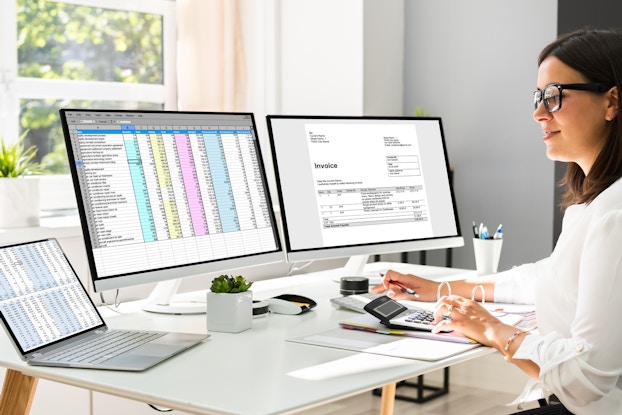
Are you new to accounting or just looking to brush up on your accounting terms as a business owner? Even if you have your own accountant, it’s important to familiarize yourself with the most common financial terms. Here are 17 terms you should know.
[Read more: A Guide to Small Business Accounting]
Accounts payable
Accounts payable is the combined bills your business owes, not including your payroll costs. Because they aren’t immediately paid, they’re considered liabilities and are usually expenses on company credit cards or bills. Accounts payable allows you to consider your current liabilities versus assets when buying something new for your company.
Accounts receivable
Accounts receivable is incoming money owed to your business for services or products received. This is considered an asset because it’s money that your business is bringing in. You typically track accounts receivable with invoices.
Accruals
Accruals are a type of accounting where you record your income as soon as it’s earned and expenses as soon as they’re billed. Therefore, your real time accounts aren’t always matching your recorded profit. Accruals give you a long-term view of your business’s future income and expenses.
Assets
Assets are resources or property with economic value owned by the business. Assets can be both tangible and intangible and can include investments, cash, inventory and real estate.
Balance sheet
A balance sheet is used as a quick insight into your business’s current financial position. It includes what the company owes and owns, as well as any capital. It allows you to compare sections of your business to understand how much your business is worth at any given time.
Break-even point
A break-even point is when you’re bringing in just enough money to cover what you owe in your business. This means your business isn’t earning or losing any profit.
Burn rate
This is the amount of time your business will be able to continue operating with the cash you have without turning a profit. It tells you how long you can be self-sustaining without a steady income.
Cash flow
Cash flow is the amount of money that’s coming into going out of your business—both your gains and losses. Your business’s cash flow is present in operating activities, investment activities and financing activities.
Credit
Credit is the money that flows out of your business’s accounts. Using credit either increases liability or revenue accounts, or decreases an asset or an expense account.
[Read more: 10 Free Accounting Tools for Your Small Business]
Businesses use forecasting to predict future business trends by looking at past financial data.
Depreciation
Depreciation happens when an asset loses its value over time. In accounting, deprecation is used as a method to allocate the cost of the asset’s life expectancy.
Dividends
Dividends refer to the amount owed to stockholders or shareholders from a company’s profits. They are a distribution of a company’s earnings, requiring the business to have a hold on its real-time losses and gains.
Expenses
Expenses are the costs a business owes for acquiring something. Expenses can be broken down into:
- Fixed: These expenses stay the same from month to month or year to year, such as rent and salaries.
- Variable: These expenses are based on a company’s production and can go up or down based on production of sales.
- Accrued: These expenses are calculated and reported but aren’t yet paid.
- Operational: These expenses are necessary for the operation of the business.
Fiscal year
A fiscal year is a measured period of time used for accounting purposes. Each company chooses its preferred timeline of what works best for them, and it doesn’t have to start in January.
Forecasting
Businesses use forecasting to predict future business trends by looking at past financial data. It can be used to predict things such as sales, gross profit or how long it will take to pay off debts.
Liabilities
Liabilities are legal or financial debts your business owes, such as mortgages, credit card debt, taxes and accounts payable.
Profit and loss statement
A profit and loss statement is also known as an income statement or an earnings statement. It helps you identify your profits and losses to evaluate your company’s current financial standing, usually quarterly.
Revenue
Your business’s revenue is the total sales and cash flow of goods and services from its primary productions.
CO— aims to bring you inspiration from leading respected experts. However, before making any business decision, you should consult a professional who can advise you based on your individual situation.
Follow us on Instagram for more expert tips & business owners’ stories.
CO—is committed to helping you start, run and grow your small business. Learn more about the benefits of small business membership in the U.S. Chamber of Commerce, here.
Next Event: Tax Filing Tips!
Join us on Thursday, February 22, at 12 pm ET for the first episode of our expert series, Ready. Set. Scale.: Smart Tax Tips for a Stress-Free Filing. We will have seasoned leaders offering actionable tips to help minimize the stressors of tax time for small businesses.








